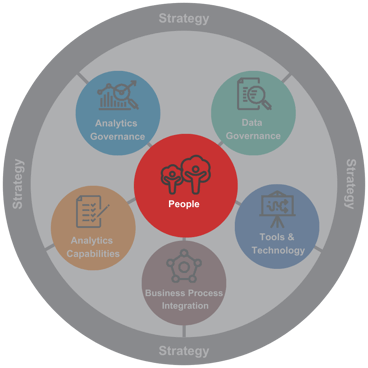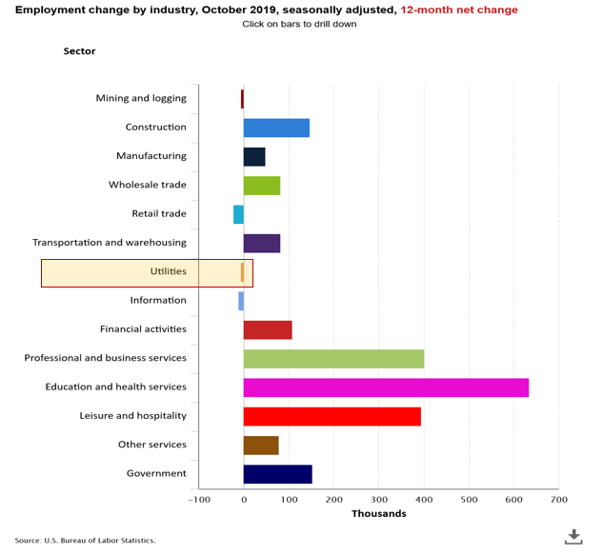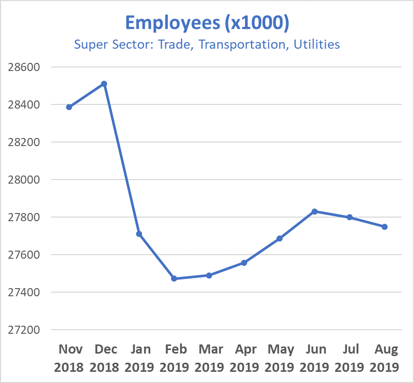
December 4, 2019
The Influence of Workforce Megatrends on Utility Analytics Initiatives

Bill Wood
Program Manager, Delivery Excellence
In my work, I see a major uptick in utilities implementing, improving or planning analytics initiatives in the next twelve months. If this sounds like you, read on.
For utilities, successful analytics initiatives can empower decision makers with data-driven insights and actionable information, but initiatives that fail to engage and empower the people in their workforce will waste time and money. The best way for utilities to guard against unproductive analytics initiatives is to know (and to properly use) the Seven Dimensions of Analytics Maturity as defined by the Utility Analytics Institute (UAI). This blog is one in a series covering all seven dimensions. (See Blog 0 of 7 – Laying the Groundwork for important background information.) Figure 1 shows a depiction of the UAI framework and highlights the focus area of today’s topic: people.

Figure 1 - Seven Dimensions of Analytics Maturity as defined by the Utility Analytics Institute (UAI)
Systems Don’t Run Analytical Utility Organizations – People Do — Don’t They?
Like all enterprises, every utility organization is made up of people. Yet, it can be extraordinarily easy to overlook or underestimate the influence of people on successful planning and execution of analytics initiatives. Akin to the adage of being ‘unable to see the forest for the trees,’ failure to properly consider ‘the people element’ can lead to bizarrely flawed conclusions. Yogi Berra once comically exemplified this type of flawed analysis in his observation about a popular restaurant:
“Nobody goes there anymore. It’s too crowded.”
So, today’s blog is about the ’people’ dimension of the UAI model for analytics maturity measurement. We will look at some megatrends in the dynamically changing workforce and discuss how changing workforce demographics should inform and influence analytics implementations.
Two Transformational Workforce Megatrends in Play
Profound and interesting changes have been working their way across the workforce at large over the past few years. While every company faces unique circumstances, all companies including utility organizations, are undeniably influenced by megatrends. Here are two items that strongly affect utility organizations and their analytics initiatives:
- Flat or negative job growth in the utilities sector
- The shift to a younger (overall) workforce
Let’s examine these one at a time.
Flat or Negative Job Growth in the Utilities Sector
Despite broad economic growth in the U.S., it is apparent that the utilities sector is striving to sustain operations with a stable or smaller staff size. This view is substantiated by recent U.S. jobs reports and historical figures available from the Bureau of Labor Statistics.

Figure 2 - Employment Change by Industry
Figure 2 shows utilities within the overall context of U.S. jobs growth over the past 12 months. It is clear from this data that the utilities sector is not sharing in the broad-based job growth across most other areas of the U.S. job market. The bottom line is simple. Utilities will face continuing pressures to increase the efficiency and effectiveness of their workforce over the foreseeable future.

Figure 3 - Sector Job Change Nov 2018 - Aug 2019
Figure 3 reinforces this expectation and provides a closer look at absolute numbers and the nature of the decline in utility jobs from Nov 2018 to Aug 2019 (the most recent month for which final figures are available).
The Shift to a Younger (Overall) Workforce
Looking beyond the utilities sector to the broader workforce, a major generational shift is clearly underway. In every industry sector across North America, the responsibilities and duties involved in sustaining business activities is being transitioned to a new generation of workers. The shift has been quietly taking place for a few years in the broader market. The utilities sector appears to have lagged a bit behind others, but the transition is now undeniably accelerating.
Have a look at Figure 4 from the Pew Research Center to get a feel for how much the broad workforce has changed in recent years in terms of generational makeup. A cursory glance at current data reveals that millennials have become the driving force in workforce demographics (and culture). In the broad market, this shift occurred between 2014 and 2016 as the millennials surpassed boomers and Gen Xers. The shift took a little longer in utilities, but it is clearly underway and has already begun to profoundly change the way utility organizations think and behave.

Figure 4 - Generational Makeup of U.S. Workforce
Megatrends Come Home
As I travel and talk with utilities across North America, I ask a lot of questions about current hiring practices and the nature of the workforce. The answers I get vary. That’s probably because things do not change everywhere all at once. Also, there is some data to support that utilities tend to lag the broader job market in this regard. Nevertheless, things are clearly changing for utilities. Less than two years ago hiring freezes seemed common. Today, some utilities indicate that hiring could remain generally slow or frozen until attrition in key positions forced changes. But on the whole these days, I hear less and less about hiring freezes and more and more about hiring fairs. While the overall number of jobs may not be growing, utilities are definitely replacing their retiring workforce with a younger one.
If you have not yet observed this shift in your own organization, you may soon. Figure 5 provides an example of how some utilities have changed profoundly already. The chart shows the results of one question from an informal interactive survey I conducted at a recent UAI event, “How long have you been involved in utilities?” The overwhelming ratio of responses indicating 'less than 5 years' shows that the portion of the utility workforce represented there was deeply into the transition we have been discussing in this blog. In this case, the respondents were equally spread across line-of-business practitioners, functional managers and IT. They were also evenly spread across individual contributors and managers. While these results may or may not be typical, they are certainly not unusual, and they are becoming more and more common.

Figure 5- Interactive Survey Question Response - Time in Utilities
The Influence of Workforce Change on Analytics Initiatives
The impact of these megatrends on utility organizations over the next three to five years will be profound. A clear understanding of the nature of these impacts can help enlightened utility organizations to formulate plans to successfully carry out analytics initiatives that achieve very high ROI by targeting areas of great need, while leveraging the culture and skills of the emerging workforce.
Here are a few observations:
- The growing number of practitioners with less than 5 years of industry experience will drive the need for analytics to replace ‘gut feel’ management with fact-based decisions supported by reliable data.
- Adoption rates for properly conceived analytics initiatives (and rejection rates for poorly conceived analytics initiatives) will accelerate. This is largely because the dominant generations in the emerging workforce come preloaded with high levels of tool proficiency and data awareness along with unabashed intolerance for lame tools and faulty paradigms.
- The appetite for improved analytics initiatives will continue for the foreseeable future. This is partly because technology will continue to advance, but also because the average experience base within the utility workforce will grow more slowly due to the tendency of the emerging workforce to change jobs and careers more often than their predecessors.
Summary
In our rendering of UAI’s Seven Dimensions of Analytics Maturity (figure 1), there is a good reason people are at the heart of the wheel. Workforce megatrends tell us that the wheel is about to start rolling much faster. In order to build an analytics-driven organization, utilities cannot overlook or underestimate ‘the people element.’
For more information…
Thank you for reading today’s blog. At Utegration we know every situation is unique. If you would be interested in having Utegration take a close and thoughtful look at your organization’s unique circumstances, please reach out to me or any of my Utegration colleagues for a no-obligation conversation.
